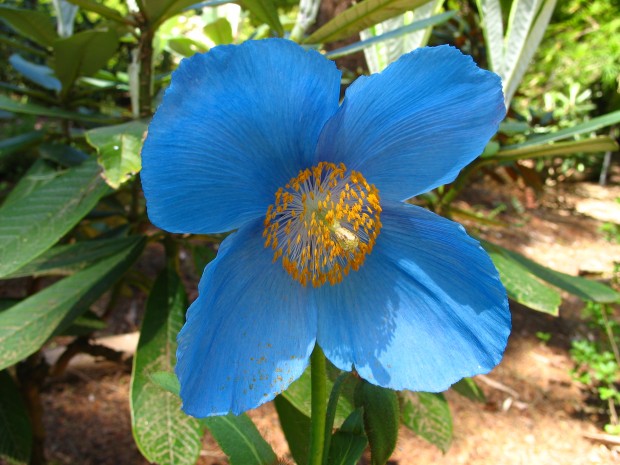Download Himalayan Blue Poppy Care Sheet

The enchanting Blue Poppy (Meconopsis) creates a spectacular show in the late spring and early summer. Such a rich true blue flower is a rare garden treasure. Blue Poppies have a reputation of being difficult to grow, but these plants can be grown successfully if you follow a few basic guidelines.
Chose a location in partial shade out of hot afternoon sun and protected from strong winds.
Soil preparation is the single most important factor. Blue Poppies demand a rich well draining soil in an area of partial shade. If planting a single plant, dig a large hole about 18 inches by 18 inches deep. Mix one part compost or well rotted manure, one part fine bark mulch (composted for 2 – 3 months, if possible), and two parts original soil. Fill your planting hole with this mixture and add a balanced organic fertilizer or other slow release fertilizer. If you are creating a larger planting of three or more plants, prepare a planting bed by spreading 2 – 3 inches of compost or rotted manure and 2 – 3 inches of fine bark mulch, and dig into the soil to a depth of 18 inches. Work slow release fertilizer or organic fertilizer into the top 3 – 6 inches. Gently loosen the roots of the poppy and place at the same depth the plants were in the pots. We recommend installing plants rather than trying to start Meconopsis from seed. Seed must be very fresh to be successful.
Water regularly during the summer. Soaker hoses are great for thorough, deep watering. If the poppies are too dry, powdery mildew could be a problem.
Use liquid fertilizer every two weeks or a balanced granular fertilizer once a month during the growing season. This will keep your plants vigorous and healthy.
In the fall an organic mulch can be applied to a depth of 2 to 3 inches. Be sure to wait until the plants are completely dormant to apply the mulch. Fall is a good time to plant Meconopsis but they must be planted early enough in the fall so they are growing strongly before going dormant. If you miss this window of opportunity, then plant them in the spring.
Sometimes Blue Poppies will die after flowering. To help your plants be perennial, pinch out all flower buds for the first year. Early every spring it is critical to protect the emerging foliage from slugs.
Enjoy the unique experience of growing these spectacular plants and, with a little luck, you will have them reseeding in your garden.
The RSBG has found Meconopsis ‘Lingholm’ to be a most reliable selection, returning year after year with pure blue blooms. They are usually available in our mail order catalog.
The RSBG has introduced several dozen new ornamental plants into cultivation. Here are a few that we are currently featuring.
PO Box 3798, Federal Way, WA 98063-3798 USA
Office 253-838-4646 • Fax 253-838-4686
Garden Gift Shop & Nursery 253-838-4646×140 • Email info@rhodygarden.org
